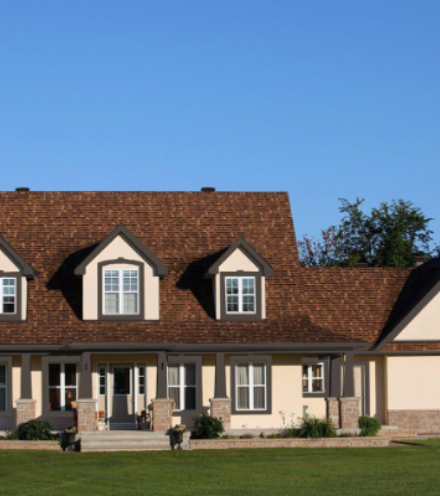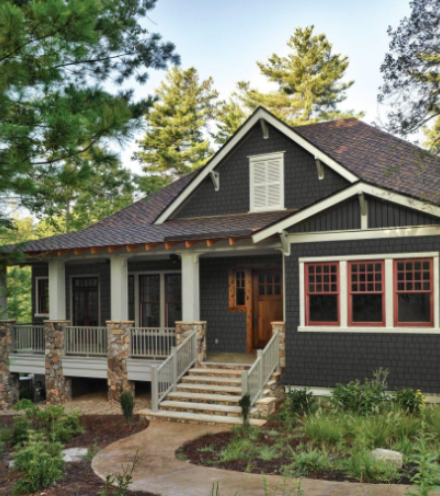Depending on where you live, you’ve probably seen a variety of homes built with popular house siding colors. Color preferences can change, both over time and based on the area the house may be located in. Region specific colors are common, but so are several colors that transcend localities, seen in many regions and on many styles of home.
Popular House Siding Colors
If you’re looking for inspiration for what may look great on your home, consider one of these of 28 popular house siding colors.
1. Autumn Red
There are few colors that evoke emotions in people more than red. As a siding color for houses, reds that are reminiscent of the old, rusty barn red that was produced through the use of linseed oil are nearly universally popular. The key is to choose a red that is closer to rust or brown, and not leaning into the fire engine category. Done correctly, Autumn Red house siding color can produce a sense of nostalgia in viewers.
2. Coastal Blue
All shades of blue have grown tremendously in popularity over the last several years. Blue may be a bold color when compared to neutral shades, but it also has soothing connotations, evoking a feeling of serenity and peace with viewers.
Houses painted in a rich Coastal Blue with a crisp white trim call to mind the feeling of peace and well-being that visitors get from a view of the sea.
3. Cypress
If you live anywhere in the northern sections of the US, you’ll probably find many houses painted in colors similar to Cypress. This muted green is close enough to a neutral to be found in many conservative areas, but has enough color to also work well in areas that value more natural colors and tones, such as those found in the trees, fields, and woods surrounding the communities.
A home painted with Cypress can also make great use of several different accent colors to help the shade fit in well in areas such as the south, where darker colored houses are preferred.
4. Desert Tan
True neutrals are universally popular, no matter what region you live in or what type of architectural style your house has. Neutrals tend to blend well with their surroundings, so they can work well in a neighborhood of differing colors or styles without clashing or calling unnecessary attention to the property.
Neutrals like Desert Tan also blend well with different accent colors, such as green shutters, for those that want a small pop of colors.
5. Flagstone
Gray has been the hot new neutral shade that everyone loves for the last several years now. Anyone that likes the idea of a neutral, but who isn’t wild about shades of tan or cream can appreciate the rich beauty of grays like Flagstone. This rich color pairs well with its neighbor shades of black and white, but will also make a red door pop or could be the background for a blue accent as well, depending on your personal tastes.
6. Forest Green
Houses located in rural areas, as well as in the north are often painted with many different shades of green that call to mind the nature that surround them. That makes Forest Green one of the most popular colors seen throughout these areas.
Forest Green calls to mind the color of trees in mid-summer, but also works well as a background color for homes that need some bold accents, like a black shutter or a red front door.
7. Granite Gray
Gray is a multi-faceted color that comes in many shades. Granite Gray is a lighter, more closely neutral gray that is nearly universally pleasing, working well in all regions and areas. Lighter than Flagstone, with a warmer undertone, Granite Gray can be used from coast to coast on many architectural styles where a light neutral color is desired, but a tan or cream is not.
8. Light Maple
Light, natural colors are also very popular in nearly all areas, particularly in New England and in most areas of the north. This includes colors like Light Maple, which is a rich tone similar to the clear color of the heartwood found in a maple tree that has been cut open.
Light Maple makes a beautiful backdrop color for homes that have more powerful accents. Use this color as the base for richer tones on shutters, doors, and trim to create a unique color way.
9. Hearthstone
Because Hearthstone is warmer than other shades of gray, it pairs better with accent colors like red, green, orange, and cream, making it a very versatile color that works on many homes.
10. Linen White
Throughout both coasts, as well as in many areas of New England, you’ll find a variety of light and white colored homes. Linen white is the perfect background color for creating a subtle, classic house palette. Paired with black shutters and a red door, Linen is a slightly warmer shade of white that can help make a home appear more approachable and homier.
11. Marigold
Looking for a warm, yet light color that will brighten your home’s exterior? Look no further than the pale, yellow tones of Marigold. This warm color is ideal at brightening and lightening a home, without making it too bold. Paired with a crisp white trim, Marigold can be found on a variety of different architectural styles and in all areas.
12. Nantucket Gray
Named for the region where it can be found on the majority of homes, Nantucket Gray is another warmer, richer shade of gray that has nearly universal appeal. Nantucket Gray is a lighter, truly neutral gray that is perfectly balanced between warm and cool, light and dark. It works well on nearly every architectural style, as well as in every region.
13. Natural Clay
Another color popular with homeowners who like white, but don’t want a stark shade on their homes is Natural Clay. This off white is cooler than cream or tan, but still warm enough to have some personality. It pairs well with tan, beige, and brown for those that want to create a monochromatic exterior for their homes.
14. Newport Taupe
Taupe was one of the colors of the year for 2017, and with good reason. This delicate shade balances perfectly between gray and beige; light enough to be considered a neutral, but cooler in tone than most neutral shades. Newport Taupe is a deeper version of the color that works very well with rich red and brown accents.
15. Olive
If you like the idea of gray, but want a little more personality and color for your home, consider Olive. Another rich green shade that works well in the north, Olive is also close enough to gray to have a more universal appeal. You can find Olive on homes in the south, as well as on the west coast as well.
16. Pacific Blue
If you love blues, but want something a little deeper and more somber, consider Pacific Blue for your home. Pacific Blue is more subdued in tone than Coastal Blue, but still maintains the nearly universal popularity that all blue shades share for homes. You can find Pacific Blue on both coasts, as well as in the south and mid-west.
17. Pewter
For homeowners that want a hint of neutral color that will work in any surrounding, consider the shade Pewter. This very light gray is cool enough in tone to work on smaller homes, making them appear larger. It also pairs well with classic color combinations, such as black and red for homeowners that want a traditional exterior.
18. Sable Brown
Homes located in the south are often painted very dark colors. Sable Brown fits in perfectly with these color schemes, giving you a rich, warm, dark color that can be the backdrop to a variety of different palettes. Pair this shade with deep reds and rusts for a dynamic design.
19. Savannah Wicker
Sometimes the color you want for your home is something perfectly balanced between light and dark, warm and cool. Savannah Wicker fits that bill perfectly; a true neutral that will work well in any circumstances and on any architectural style.
20. Snow White
Many people love the classic look of white for their home. Snow White gives you that crisp, clean color that pairs so well with other classic shades like gray, black, and red. Mixed together, this palette really pops on traditional architecture.
21. Sterling Gray
Sterling Gray is another very light gray siding that works well in numerous situations. One of the lightest shades available, Sterling is a true gray, with no warm undertones. It works well with other cool colors like blue, green, and black to create a harmonious exterior.
22. Suede
Suede, pictured here with Desert Tan, is a rich, warm color made to pair well with others. If you want a color for your home that invites people in, Suede is the perfect color for the job. The color also works well with other light and dark shades, letting you create a unique and cohesive palette.
23. Wicker
Light colored homes are popular nearly everywhere, and Wicker is another color that lets you have just a hint of something special on your exterior, without overwhelming the area with color. This soft off-white isn’t quite cream or beige, but a unique tone that blends beautifully with many architectures.
24. Cedar
Not every home looks its best painted a solid color; some homes show off their true potential when stained instead. Cedar stain is a warm, rich color that allows the character of the home to show through. Use it alone, or pair it with a cool tone for contrast.
25. Maple
Maple is another stain that works well on numerous homes and accessories, such as this fence. A light, clear color, Maple adds just a hint of personality and depth of interest to the areas it’s applied to.
26. Mahogany
Stains don’t have to be light or warm in color to be effective. This Mahogany stain is the perfect complement to rustic homes and buildings. The warm, brown tones of the stain will allow the building to fit in well with any surroundings.
27. Emerald
Stains can also be very effective when they contain a true color as well. Used over the entirety of the home, or as an accent when paired with another stain, Emerald lets homes shine with a wash of color that highlights the depth of the wood grain.
28. Redwood

For many homeowners, there’s nothing like the rich, red color of Redwood when a stain is what’s desired. The color here pulls viewers in, making the home look inviting and pleasant to the eye.




